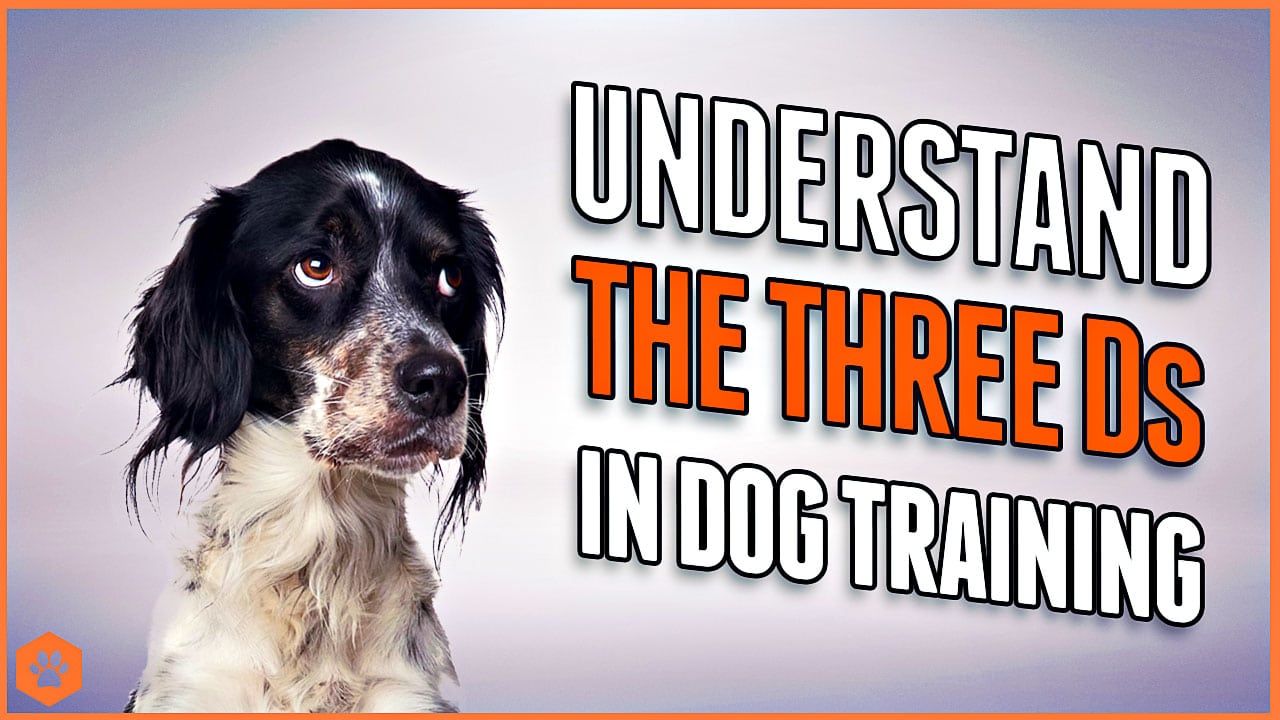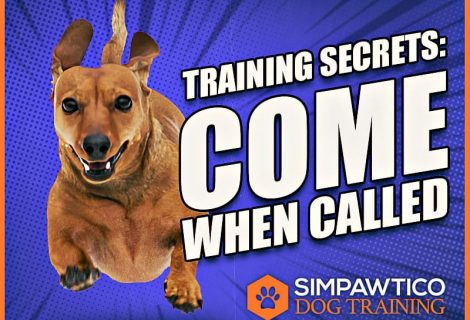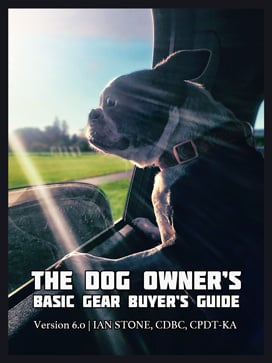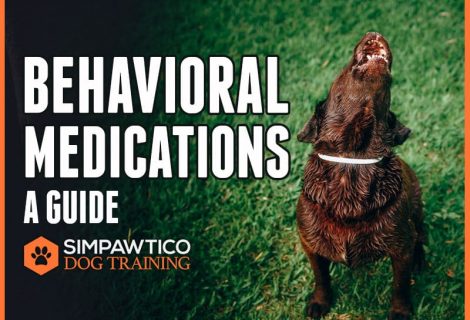The Three D’s of Dog Training: How to Balance Duration, Distance, and Distraction
Three things affect how well your dog listens to you: distance, duration, and distraction. In dog training, we call these “The three D’s.” You must understand these three factors and how they work together to manage your dog’s behavior. In this blog post, we’ll take a closer look at each of them and discuss how you can use them to your advantage when training your dog. Stay tuned for more tips on how to create a well-behaved pup!
NOTE: This blog post will focus mainly on how we do it here at Simpawtico. While the tips and advice we give will work for most dog owners, understand that every dog is different. As such, you may need to tailor our methods to fit your own dog’s ability. But regardless of what approach you take, “the three D’s” of dog training will always be influential!
INTRODUCING THE THREE FACTORS THAT AFFECT DOG BEHAVIOR
When training your dog, it’s essential to understand how the three D’s affect your dog’s behavior. Duration is how long your dog remains in the desired behavior. Distance is how far away you are from your dog when giving prompts. And distraction is anything that takes your dog’s attention away from you and your prompts.
You must know how these three factors work together to improve your dog’s behavior. When you start introducing these factors into your training, generally, you’ll do so in order: duration first, then distance, and finally, distraction. Naturally, not every behavior you teach your dog will use all three. But all things involve at least one of them in some fashion or another, and so having a grasp of their interconnectedness helps you visualize where you need to go with your dog training to find success.
UP-TITRATION
One common thread you’ll notice in all three D’s is to build them up slowly. This is called “up-titration,” and it’s the best way to help your dog be successful. When you first start training your dog, they likely won’t be able to handle long durations, far distances, or high levels of distractions. So it’s crucial that you slowly introduce these things over time. Then, as your dog gets better at the behavior, you can increase the duration, distance, and distraction.
For example, let’s say you’re teaching your dog to “sit.” You’ll want to ask them to sit for just a few seconds. Once they’re able to do that consistently, you can start to increase the duration by asking them to sit for extended periods. Once they can do that, you can increase the distance by asking them to sit while you’re further away from them. And finally, once they do all that, you can start introducing distractions by asking them to sit while other things are happening around them. Incidentally, this is the template for teaching a formal stay, and we’ll come back to this in a second.
Remember, the key is taking things slowly and gradually increasing the difficulty. If you try to do too much too soon, you’ll likely just end up frustrating both you and your dog!
DURATION
First and foremost among the three D’s is duration. To further improve your dog’s behavior, you must first understand the importance of duration. Duration is the length of time your dog remains in the desired behavior. The longer they stay stable in the behavior, the better the chance they will perform it correctly. You can increase duration by gradually raising the time they spend in the behavior and rewarding them for prolonging it. Behaviors that incorporate duration variables include:
- Formal stays—the time spent during the stay is a big part of this skill.
- Leave it—resisting interacting with something in the environment over time becomes just as important as leaving the thing alone in the first place. After all, you may be unable to intervene immediately, e.g., if you’re carrying groceries and something drops. You need that “leave it” to last for several seconds or even minutes!
- Loose leash walking—walking is, at its heart, a duration behavior. We ask our dogs to walk nicely with us for a specific time. Maintaining polite behavior is an important life skill as dogs navigate the human world with us.
At Simpawtico, we use a “duration marker.” We make this sound to let the dog know that they are doing the behavior correctly and will soon get a reward. This helps the dog understand that the longer they remain in the behavior, the more likely they are to get rewarded. We use the word “Good” for this. Our duration marker is NOT interchangeable with our terminal marker, “Yes!” Remember that “Yes!” means “YOU DID IT RIGHT,” and it comes at the end of something. In contrast, “Good” means “Keep going,” and we use it to squeeze a little more time out of a behavior. We’ll talk about how to train duration in a bit; if you want to learn more about markers, we have a post HERE.
DISTANCE
The second factor that affects dog behavior is distance. Distance is how far away you are from your dog when giving prompts. The closer you are to your dog, the more likely they will respond to your prompts. You can expand your reach by increasing distance gradually. As skill builds, you’ll be able to move further away while still maintaining their attention. Distance is a special kind of problem for dogs to overcome because they struggle with decoding distance commands. This is why most dog training problems are solved by getting the owner closer to the dog.
You can undoubtedly teach as much distance to a dog as you want; I have friends that do field trials with their springers, and they have a 300-yard range on those dogs; it’s incredible. But that didn’t happen overnight. That reliability is due to careful and diligent practice over time, starting with a short distance. Behaviors with important distance variables include:
- Distance prompts—being able to give prompts at a distance like “sit” or “down.” Usually, skills degrade the farther away you get.
- Come-when-called—if your dog is a good distance from you when you call them, the harder it typically is to be successful. There are a lot of exciting things in that space between you and them!
- Waits and stays—being able to move away from your dog is sometimes a tough nut to crack. The farther you get from your dog, the more likely they will break the stay and find you (or toddle off to other, more attractive pursuits).
- Off-leash time is where your engagement, distance prompts, and recall crystallize. A dog should be able to get a reasonable distance from you and still be “connected.”
- Fetch and retrieve—the farther away you pitch the decoy, the less control you may have. Many dogs are naturals at this, but others can get diverted easily.
DISTRACTIONS
Distraction level is the third factor you must consider when training your dog. Distractions can come from anything that takes your dog’s attention away from you and the task at hand. It can be noise, an animal, another person, or anything that catches their interest. The best way to overcome challenging distractions is by starting small and teaching your dog how to focus on you and the assignment. You can do this by using controlled distractions, keeping prompts short and straightforward, and rewarding them for following directions quickly.
You have to work through the distraction variable with all public behaviors. It’s the toughest one and the one that most people rush through. You can’t just go to the park one day and expect your dog to be perfect with all the other dogs and people around. It takes time and patience to overcome more challenging distractions! Behaviors with important distraction variables include:
- Come-when-called—Your dog may be like, “I’m coming! I’m coming! I’m co…SQUIRREL!”
- Loose leash walking is where walking can fall because of competing motivators. This is especially difficult for a reactive dog.
- Waits and stays—it’s hard to maintain a position when other things are begging to be investigated!
HOW TO OVERCOME THESE CHALLENGES WHEN TRAINING YOUR DOG
So how do you overcome the three challenges of duration, distance, and distraction when training your dog?
APPLY THEM IN ORDER
First, you need to be aware of how these factors work together. Typically we design training exercises so that you and your dog work through each of the Three D’s systematically and in order. That means you address duration first, then distance, and distractions last. This is a dog training Master Key.
GRADUAL INCREASE DURING TRAINING EXERCISES
Second, you must start small and gradually increase the difficulty level as your dog masters the skills. Most pet owners struggle with their training because they expect too much in the beginning stages—they attempt long instead of short duration, add distance too quickly, and try it all out in areas with too many distractions. Listen: nobody ever picked up a guitar for the first time and played Van Halen; some essential pieces need to be learned FIRST. For instance, when people try to teach their dogs how to stay, they usually start walking away right from the very first try. As a result, the dog breaks over and over, both the dog and the human get frustrated, and it’s a sloppy, unorganized process. So, remember that it’s duration first, then distance, then distractions:
- Build duration toe-to-toe (no distance) in the position. Practice this progressively in a neutral, distraction-free environment like a quiet kitchen. You’re just building the basics of the skill.
- Layer distance over that, starting with a half-step. Get it right before trying to go further. If you can’t get the half-step, there’s no way you’ll get any farther than that!
- You can introduce small distractions when you’ve got time and distance going well. When you’ve mastered those, crank it up slowly and master each new phase.
This may sound like a lot of steps, but if you practice a little each day, you could get a pretty impressive base for staying in a week. You just need an organized and supportive progression. In another example, let’s say you’re working on recalls. People struggle with this because they don’t pay attention to the three D’s and ask for too much before the dog is ready.
So, you might start in the house with minimal distractions. Then, once your dog is consistently coming when called, you can move to the backyard with a few distractions like toys or people walking by. By continuing to increase distance and distraction in small increments, you’ll be able to build a pretty solid recall.
MOTIVATE THE WHOLE TIME
Third, be patient and consistent with your training. Dogs learn best through positive reinforcement, so ensure you reward your dog for their good behavior at every step. Celebrate a 30-second stay at 1 foot with the same enthusiasm you eventually will for that 3-minute stay at 10 feet. Like people, dogs learn with encouragement and clear goals within their ability to attain. Ensure you reward your dog with treats, petting, or verbal praise throughout the training process. This will help them stay motivated and keep on performing.
Incidentally, this is one of the reasons we love using our duration marker, “Good.” You can use your tone and volume to communicate more without being super wordy (which most dogs will tune out). If I keep most “good” markers neutral, I can give one a little “sizzle” to communicate that what my dog just did was “gooder” than a second ago. This analog data is super valuable in dog training (and I don’t think dog trainers use it enough, IMHO).
THREE D’s OF DOG TRAINING TIPS FOR SUCCESS!
Here are some more quick tips to ensure success when designing training sessions around the Three D’s. If you raise the criteria on one of the D’s, lower the criteria on another. This probably feels like such a small detail, but it’s a big deal. For example, if I’m teaching that formal stay and I try to push the distance, I will do less time and make sure there are no distractions. I can layer those on later, but distance is the focus of that particular trial.
Likewise, once I move the practice from the kitchen to another area, I will ask for less time and less distance because I’ve increased the level of ambient distractions in the environment. If I can get a stay for 3 minutes at 10 feet in the kitchen, I will not expect that in the backyard initially. I’ll probably start at 30 seconds at one step away—OR LESS, depending on the distractions out there! From there, we can climb the ladder systematically and build a bomb-proof stay under many conditions. This is smart dog training.
Don’t rush! Move through the progression supportively and attain mastery at each step. As you play around with criteria, keep training sessions short and always end on a positive note by celebrating success, no matter how small. Always work within the dog’s ability. Most dogs can only take in so much training information at once, especially when acquiring new behavior. This is even more crucial for a new puppy.
USE A TIMER
One of the challenges with duration is that it can be hard to keep track of the time. I recommend using a timer. This gives you some accurate data and goals. Real numbers instead of estimating on the fly will help you set realistic goals as your dog learns. The exception to using a timer is during a duration behavior like walking on a leash. During a walk, you’re mainly concerned with maintaining a continuous behavior rather than aiming for extended time frames for passive behaviors (as in stay). However, we recommend breaking up a walk into blocks punctuated with sniff ‘n’ stroll time.
DISTANCE TECH TIP:
When working distance, the point where your dog responds to a prompt is the proximal prompt, and the zone where they stop responding is the distal prompt. You can stretch distance by pairing these with classical conditioning. So, for example, your dog may respond to the “down” prompt at three feet but not at five. Three feet is the proximal, and five feet is distal. So, pair them together by saying the distal, followed right away by stepping closer and giving the proximal. After several reps, your dog will learn to anticipate the follow-up and preemptively respond to the distal. Praise the heck out of this! Soon, five feet will be the new proximal (congratulations!), and beyond that is the new distal. Keep working to stretch the distance farther and farther! Most dogs will generalize this after several rounds and then you can start stretching distance faster and farther. Incidentally, if you’d like to learn more about classical conditioning, you can read more about here!
THE QUALITY OF DISTRACTIONS MATTERS
Understand that when working with distractions, you must take great care about introducing scary ones. Most distractions you’ll have to worry about involve intriguing stimuli like toys, people, or even other dogs. As long as these are things that catch your dog’s interest, you’re fine. However, if a distraction provokes a flight response or aggression, you should bring a certified pro to help desensitize your dog. If you have a dog that struggles with fear or anxiety in public, forcing them to behave when they don’t feel safe is inhumane. Clear out the toxic emotional content before trying to do the technical stuff. A certified dog trainer or behavioral consultant ought to be able to help you sort it out.
CONCLUSION
Now that you understand the three D’s of dog training, you can start to work on training your pooch more effectively. By following these tips, you’ll be able to balance the three factors of duration, distance, and distraction when training your dog. With time and patience, you’ll be able to overcome any challenges and train your dog successfully! Do you have any tips for training your dog? Please share them in the comments below! In the meantime, keep learning, keep practicing, and we’ll see you next time!











